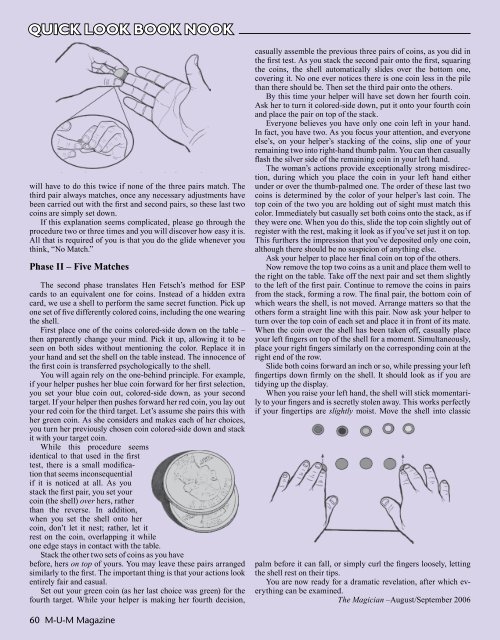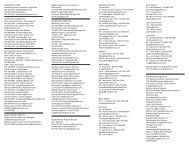(Hank) Moorehouse 1934 – 2011 - The Society of American Magicians
(Hank) Moorehouse 1934 – 2011 - The Society of American Magicians
(Hank) Moorehouse 1934 – 2011 - The Society of American Magicians
Create successful ePaper yourself
Turn your PDF publications into a flip-book with our unique Google optimized e-Paper software.
QUICK LooK BooK NooK<br />
will have to do this twice if none <strong>of</strong> the three pairs match. <strong>The</strong><br />
third pair always matches, once any necessary adjustments have<br />
been carried out with the first and second pairs, so these last two<br />
coins are simply set down.<br />
If this explanation seems complicated, please go through the<br />
procedure two or three times and you will discover how easy it is.<br />
All that is required <strong>of</strong> you is that you do the glide whenever you<br />
think, “No Match.”<br />
Phase ii <strong>–</strong> five matches<br />
<strong>The</strong> second phase translates Hen Fetsch’s method for ESP<br />
cards to an equivalent one for coins. Instead <strong>of</strong> a hidden extra<br />
card, we use a shell to perform the same secret function. Pick up<br />
one set <strong>of</strong> five differently colored coins, including the one wearing<br />
the shell.<br />
First place one <strong>of</strong> the coins colored-side down on the table <strong>–</strong><br />
then apparently change your mind. Pick it up, allowing it to be<br />
seen on both sides without mentioning the color. Replace it in<br />
your hand and set the shell on the table instead. <strong>The</strong> innocence <strong>of</strong><br />
the first coin is transferred psychologically to the shell.<br />
You will again rely on the one-behind principle. For example,<br />
if your helper pushes her blue coin forward for her first selection,<br />
you set your blue coin out, colored-side down, as your second<br />
target. If your helper then pushes forward her red coin, you lay out<br />
your red coin for the third target. Let’s assume she pairs this with<br />
her green coin. As she considers and makes each <strong>of</strong> her choices,<br />
you turn her previously chosen coin colored-side down and stack<br />
it with your target coin.<br />
While this procedure seems<br />
identical to that used in the first<br />
test, there is a small modification<br />
that seems inconsequential<br />
if it is noticed at all. As you<br />
stack the first pair, you set your<br />
coin (the shell) over hers, rather<br />
than the reverse. In addition,<br />
when you set the shell onto her<br />
coin, don’t let it nest; rather, let it<br />
rest on the coin, overlapping it while<br />
one edge stays in contact with the table.<br />
Stack the other two sets <strong>of</strong> coins as you have<br />
before, hers on top <strong>of</strong> yours. You may leave these pairs arranged<br />
similarly to the first. <strong>The</strong> important thing is that your actions look<br />
entirely fair and casual.<br />
Set out your green coin (as her last choice was green) for the<br />
fourth target. While your helper is making her fourth decision,<br />
60 M-U-M Magazine<br />
casually assemble the previous three pairs <strong>of</strong> coins, as you did in<br />
the first test. As you stack the second pair onto the first, squaring<br />
the coins, the shell automatically slides over the bottom one,<br />
covering it. No one ever notices there is one coin less in the pile<br />
than there should be. <strong>The</strong>n set the third pair onto the others.<br />
By this time your helper will have set down her fourth coin.<br />
Ask her to turn it colored-side down, put it onto your fourth coin<br />
and place the pair on top <strong>of</strong> the stack.<br />
Everyone believes you have only one coin left in your hand.<br />
In fact, you have two. As you focus your attention, and everyone<br />
else’s, on your helper’s stacking <strong>of</strong> the coins, slip one <strong>of</strong> your<br />
remaining two into right-hand thumb palm. You can then casually<br />
flash the silver side <strong>of</strong> the remaining coin in your left hand.<br />
<strong>The</strong> woman’s actions provide exceptionally strong misdirection,<br />
during which you place the coin in your left hand either<br />
under or over the thumb-palmed one. <strong>The</strong> order <strong>of</strong> these last two<br />
coins is determined by the color <strong>of</strong> your helper’s last coin. <strong>The</strong><br />
top coin <strong>of</strong> the two you are holding out <strong>of</strong> sight must match this<br />
color. Immediately but casually set both coins onto the stack, as if<br />
they were one. When you do this, slide the top coin slightly out <strong>of</strong><br />
register with the rest, making it look as if you’ve set just it on top.<br />
This furthers the impression that you’ve deposited only one coin,<br />
although there should be no suspicion <strong>of</strong> anything else.<br />
Ask your helper to place her final coin on top <strong>of</strong> the others.<br />
Now remove the top two coins as a unit and place them well to<br />
the right on the table. Take <strong>of</strong>f the next pair and set them slightly<br />
to the left <strong>of</strong> the first pair. Continue to remove the coins in pairs<br />
from the stack, forming a row. <strong>The</strong> final pair, the bottom coin <strong>of</strong><br />
which wears the shell, is not moved. Arrange matters so that the<br />
others form a straight line with this pair. Now ask your helper to<br />
turn over the top coin <strong>of</strong> each set and place it in front <strong>of</strong> its mate.<br />
When the coin over the shell has been taken <strong>of</strong>f, casually place<br />
your left fingers on top <strong>of</strong> the shell for a moment. Simultaneously,<br />
place your right fingers similarly on the corresponding coin at the<br />
right end <strong>of</strong> the row.<br />
Slide both coins forward an inch or so, while pressing your left<br />
fingertips down firmly on the shell. It should look as if you are<br />
tidying up the display.<br />
When you raise your left hand, the shell will stick momentarily<br />
to your fingers and is secretly stolen away. This works perfectly<br />
if your fingertips are slightly moist. Move the shell into classic<br />
palm before it can fall, or simply curl the fingers loosely, letting<br />
the shell rest on their tips.<br />
You are now ready for a dramatic revelation, after which everything<br />
can be examined.<br />
<strong>The</strong> Magician <strong>–</strong>August/September 2006



